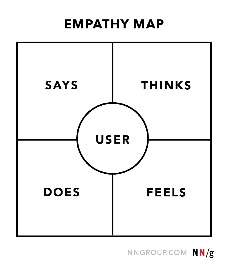What is an Empathy Map to a Persona?
Reading Time 4 mins
When creating new services or products you can ensure you genuinely meet the end-user's needs with Personas, but another informative method is Empathy Maps that can build into personas. Personas help you create detailed profiles of your target users, giving you a deeper understanding of who they are, their goals, and what motivates them. On the other hand, empathy maps dive into the specific experiences and emotions of individual users, helping you empathize with their joys, frustrations, and needs. By using these methods, you can go beyond assumptions and truly connect with your users, ensuring that your designs and services are user-centered and deliver meaningful experiences that delight users and customers. In both cases they externalize knowledge about users in order to 1) create a shared understanding of user needs, and 2) aid in business decision making.
The key differences between empathy mapping and personas lie in their focus and level of detail. Here are the explicit differences:
- Focus: Empathy mapping focuses on understanding the emotions, thoughts, behaviors, and needs of a non-identified individual user during a specific experience or journey. It delves into the user's perspective and aims to uncover deeper insights into their emotional motivations and pain points. Personas, on the other hand, is a fictional characterization of many users that can represent multiple broad user groups and provide a holistic view of their story, specific characteristics, frustrations, goals, behaviors, and needs.
- Level of Detail: Empathy maps capture specific details and nuances of an individual user's experience, often in a visual format. They highlight specific observations, quotes, and key moments to deepen empathy and understanding. Personas, in contrast, provide a visual representation of user segments. They aggregate data and insights from many users to create a categorized composite profile that helps guide business decision-making and design efforts.
The process of using these methods typically involves a collaborative visualization following these outlined steps.
| Empathy Mapping: | Personas: |
|---|---|
|
|
By understanding these differences and following the respective processes, teams can gain valuable insights and create user-centered solutions that meet the needs of individual users and broader user segments alike.
Resources:
Interaction Design Foundation: https://public-media.interaction-design.org/pdf/Empathy-Map.pdf
Nielsen Norman Group: https://www.nngroup.com/articles/empathy-mapping/
HCD Methods- Empathy Maps: Empathy Maps
HCD Methods-Personas: Personas
HOWARD MONTGOMERY
Howard is a practicing agnostic Human-Centered Design Thinking expert who thrives across the consumer experience continuum of products, services, digital, brand, strategy, and environments. He has led, collaborated and consulted with multiple Fortune 100 companies: Ford Motor, Unilever, BMW, The Home Depot, Steelcase, P&G and LG Electronics across diverse business sectors; building products, automotive, consumer, food and healthcare. He holds 48 International Patents and has been the recipient of over 25 international awards including IDEA Awards, iF Award and Good Design Award, and multiple publications of his work. He has taught at several schools in the USA and UK. He holds a bachelor’s degree with honors from Kingston University, London, UK and master’s degree from Cranbrook Academy of Art, Bloomfield Hills, USA, both in Design.
Personas, Customer Segmentation and Target Groups – How do they work together?
Reading Time 6 min
This is a short and insightful article about what are the differences between Personas, Customer Segmentation and Target Groups, and how these three tasks work together.
Most of us know and use personas, a fictional representation or archetype of a specific user. It is created to help development teams understand and empathize with the needs, behaviors, motivations, and goals of their users.
Personas are typically based on research data and observations of real users, providing a way to humanize and visualize the intended audience. By using personas, design teams can make more informed decisions during the design process, ensuring that their products or services effectively address the needs and preferences of the users.
| Customer Segmentation | Example: To help explain here’s an example of customer segmentation for a fitness apparel company: | By segmenting the customer market, the fitness apparel company can develop specific product offerings, dedicated services and create communications that resonate with each specific segment's unique needs and preferences. |
|---|---|---|
| Customer segmentation is the process of dividing a larger market or customers into distinct groups or segments based on specific characteristics, behaviors, or demographics. The goal of customer segmentation is to identify and understand different subgroups within a market that share similar needs, preferences, or behaviors. By segmenting customers, teams can tailor their strategies, products, and services to effectively meet the unique needs of each segment. Customer segmentation allows teams and leaders to target their resources more efficiently, improve customer satisfaction, and drive better marketing outcomes by delivering more relevant and personalized experiences to different customer groups. | Segment 1: Fitness Enthusiasts
Segment 2: Yoga and Pilates Practitioners
| Segment 3: Outdoor Adventurers
Segment 4: Beginner Fitness Participants
|
| Target Group | Example: By targeting this specific group, the fitness apparel company can develop products and services that cater to the preferences and needs of active women in their 20s-30s. This may involve creating stylish and versatile clothing lines, leveraging social media and influencer collaborations for promotion, and emphasizing the combination of fashion and functionality in their product messaging. |
|---|---|
| A target group, also known as a target audience or target market, refers to a specific segment of consumers or individuals that a team or organization aims to reach and engage with through its products and services. The target group is identified based on various factors such as demographics (age, gender, income, location), psychographics (lifestyle, values, interests, stages of life), behavior (purchasing habits, usage patterns, need drivers), or other relevant characteristics. The target group represents the primary recipients or potential customers who are most likely to have a need or interest in what the business offers. By defining a target group, teams and leaders can focus their business strategies, messaging, and product development efforts to effectively cater to the needs and preferences of this specific audience. | Target Group: Active Women in their 20s-30s
|
How do these three methods work together?
This is a five-point roadmap for how to consider aligning and how to interplay personas, customer segmentations, and target groups in an integrated effort.
- Develop Customer Segmentation: Start by identifying and segmenting your customer base based on relevant criteria such as demographics, psychographics, behavior, or other key factors. This will help you understand the different groups of customers you are targeting and their specific needs.
- Create Personas: Use the insights from customer segmentation to create detailed differentiated personas that represent each identified customer segment. Personas are fictional characters that embody the characteristics, goals, and behaviors of the target customers within each segment. Personas provide a humanized understanding of your customers, and their pain points and help guide decision-making throughout the design and development process.
- Align Target Groups: Map each persona to the respective customer segment it represents. This ensures that the personas accurately reflect the characteristics and needs of the target groups. By aligning personas with the target groups, you ensure that the personas are relevant and representative of the customers you are trying to reach.
- Integrate Efforts: Use personas and customer segmentations to guide various projects and activities. This includes UX development, customer experience design, and communication strategies. Consider the unique needs, preferences, and behaviors of each persona and target group when making decisions and designing experiences.
- Continuous Feedback and Iteration: Regularly update and refine your personas and customer segmentations based on new insights, market trends, and customer feedback. Ensure that the personas and target groups remain aligned and reflect the evolving characteristics of your customer base.
By harmonizing the use of personas, customer segmentations, and target groups, you can create a more unified and customer-centric approach throughout your project and programs. This integration enables more targeted and personalized strategies, leading to better customer understanding, improved products/services, and more effective marketing efforts.
HOWARD MONTGOMERY
Howard is a practicing agnostic Human-Centered Design Thinking expert who thrives across the consumer experience continuum of products, services, digital, brand, strategy, and environments. He has led, collaborated and consulted with multiple Fortune 100 companies: Ford Motor, Unilever, BMW, The Home Depot, Steelcase, P&G and LG Electronics across diverse business sectors; building products, automotive, consumer, food and healthcare. He holds 48 International Patents and has been the recipient of over 25 international awards including IDEA Awards, iF Award and Good Design Award, and multiple publications of his work. He has taught at several schools in the USA and UK. He holds a bachelor’s degree with honors from Kingston University, London, UK and master’s degree from Cranbrook Academy of Art, Bloomfield Hills, USA, both in Design.
 ISG Playbook
ISG Playbook APIs
APIs






